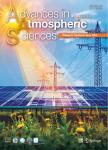The Climate Response to Global Forest Area Changes under Different Warming Scenarios in China
作者机构:School of Atmospheric SciencesNanjing UniversityNanjing 210023China Frontiers Science Center for Critical Earth Material CyclingNanjing UniversityNanjing 210023China Glarun Technology Co.Ltd.Nanjing 211106China
出 版 物:《Advances in Atmospheric Sciences》 (大气科学进展(英文版))
年 卷 期:2023年第40卷第6期
页 面:1073-1088页
核心收录:
学科分类:07[理学] 09[农学] 0903[农学-农业资源与环境] 0706[理学-大气科学]
基 金:jointly supported by the National Natural Science Foundation of China under Grant No. 41975081 the Research Funds for the Frontiers Science Center for Critical Earth Material Cycling Nanjing University the Fundamental Research Funds for the Central Universities (Grant No. 020914380103)。
主 题:land use/land cover change deforestation radiative forcing scenario regional climate
摘 要:Human activities have notably affected the Earth’s climate through greenhouse gases(GHG), aerosol, and land use/land cover change(LULCC). To investigate the impact of forest changes on regional climate under different shared socioeconomic pathways(SSPs), changes in surface air temperature and precipitation over China under low and medium/high radiative forcing scenarios from 2021 to 2099 are analyzed using multimodel climate simulations from the Coupled Model Intercomparison Project Phase 6(CMIP6). Results show that the climate responses to forest changes are more significant under the low radiative forcing scenario. Deforestation would increase the mean, interannual variability, and the trend of surface air temperature under the low radiative forcing scenario, but it would decrease those indices under the medium/high radiative forcing scenario. The changes in temperature show significant spatial heterogeneity. For precipitation, under the low radiative forcing scenario, deforestation would lead to a significant increase in northern China and a significant decrease in southern China, and the effects are persistent in the near term(2021–40), middle term(2041–70), and long term(2071–99). In contrast, under the medium/high radiative forcing scenario, precipitation increases in the near term and long term over most parts of China, but it decreases in the middle term, especially in southern, northern,and northeast China. The magnitude of precipitation response to deforestation remains comparatively small.



